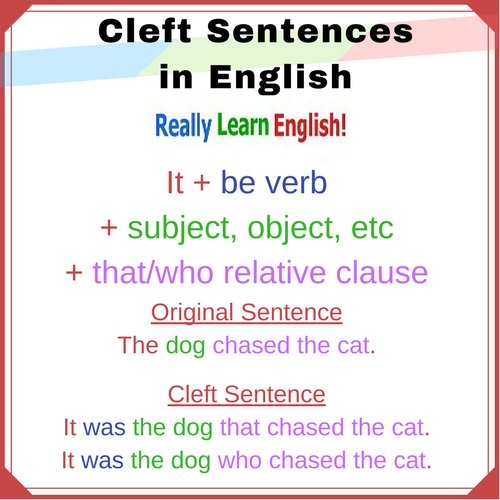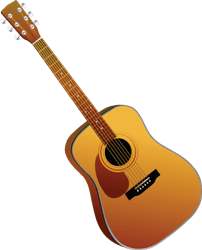Cleft Sentences
There are several ways to add emphasis (focus) to parts of your sentences in English by changing the word order. Cleft sentences are one way to add emphasis to what we want to say.
The word "cleft" means divided or split.
A cleft sentence is a sentence in which some part is moved from its normal position into a different place to give it more emphasis.
For example, instead of saying:
Joe ate the cake.

We could say:
It was Joe who ate the cake.
This puts the emphasis on the word Joe. This is a cleft sentence.
Cleft sentences are used in spoken and written English, but they are more common in written English.
Click Here for Step-by-Step Rules, Stories and Exercises to Practice All English Tenses
Cleft sentences help us focus on a certain part of a sentence to add emphasis to what we want to say. We use cleft sentences to to connect what is already understood to what is new to the listener. Cleft sentences let us focus on the new information.
Cleft sentences are more common in written English because we cannot use intonation in written English. (Intonation is the rise and fall in the pitch of your voice when speaking.)

Cleft comes
from the verb to cleave,
meaning to divide into two.
Cleft sentences
are divided into two clauses.
Each clause has its own
verb.
There are different types of cleft sentences. The most common types are
the IT sentence patterns
and the WH sentence
patterns. We will focus
on these two types of cleft sentence patterns in this lesson.

IT cleft sentences
This is the basic pattern of an IT
cleft sentence:+ that/who relative clause
- It
was the boys who started the fight.
- It
is rain that cancels parades.
- It
is the secretary that I wish to thank.
- It was my mother who taught me to love.

You can use other pronouns in place of "it" to make cleft sentences.
- Those
were my books that you borrowed.
- That
is my pencil that you broke.
- There is the guitar that I want to purchase.

We use cleft sentences to to connect what is already understood to what is new to the listener. Cleft sentences let us focus on the new information.
Examples:
– No, it was Mrs. Smith that I met.
In the second sentence, the focus is on the new information: Mrs. Smith.
The understood information (old information) is at the end: I met your teacher.

– Those were my books that you borrowed.
Understood (old) information: You borrowed someone's books

– It was Tuesday that I called you.
Understood (old information): I called you

In informal situations, we sometimes leave out "that" in cleft sentences.
Examples:
- It was Mrs. Smith that I met.
It was Mrs. Smith I met.
- Those were my books that you borrowed.
Those were my books you borrowed.
- It was Tuesday that I called you.
It was Tuesday I called you.
Cleft sentences can also be negative sentences.
Examples:
- It wasn't
Mr. Jones that I met.
- It was
not
those boys who started the fight.
- It wasn't
Monday that I called you.
- That is not the guitar
that I wanted to purchase.
- Those were not my books you borrowed.

WH cleft sentences (pseudo cleft
sentences)
WH cleft sentences are also sometimes called pseudo cleft sentences.
In pseudo-cleft sentences, the emphasis (focus) is usually at the end of the sentence.
This is the basic structure of a WH (pseudo) cleft sentence.
These cleft sentences begin with WH words such as what, why, where and the words all, the thing, something, one thing.
In WH cleft sentences, the understood (old) information is at the beginning of the sentence rather than the end of the sentence. The focus (new information) is at the end of the sentence.
Examples:
– What I need is something to drink.
In the second sentence, the focus is on the new information: I need something to drink.
The understood information (old information) is at the beginning: I need something.

– The one thing I want is to be rich.
Understood (old information): I want something

– All I want for Christmas is you.
Understood (old information): I want something for Christmas

More pseudo cleft sentences (WH clefts):
- What
I need now is a cup of tea.
- The
first thing I notice about people is their smiles.
- What's
really important to me is my family.
- All
she was trying to do was earn his respect.
- The one thing I love the most is ice cream.

Modal verbs in cleft sentences
Modal
verbs can also be used in cleft sentences to add emphasis.Examples:
- It might
be my phone that you hear ringing.
- It must
have been his mother who taught him how to grow sunflowers.
- It may
have been my fault that the plant died.
- It could
have been Mrs. Smith that I met.
- What I need now might be a cup of
tea.
- What's really important to me should be my family.
- The one thing I love the most may be ice cream.
- The first thing I notice about people could be their smiles.

Get Updates, Special Offers, and English Resources
Download your FREE GIFT (the first two chapters of
English Short Stories Book and Workbook)
as soon as you join!

By submitting your email, you consent to receiving updates and newsletters from us and to the sharing of your personal data with third parties for the purposes of sending you communications. We will not spam you. You can unsubscribe at any time. For more information, please see our privacy policy.
Return
from Cleft Sentences to Using Word Order for Emphasis





